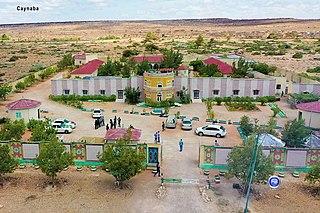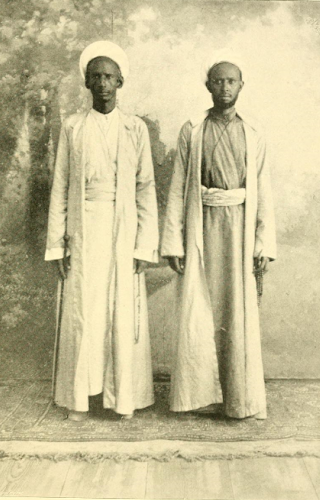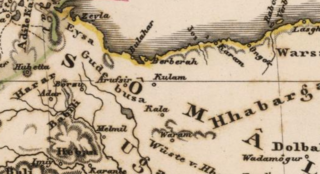Karin | |
|---|---|
Village | |
| Coordinates: 10°52′51″N45°45′42″E / 10.88083°N 45.76167°E | |
| Country | |
| Region | Sahil |
| District | Berbera District |
| Time zone | UTC+3 (EAT) |
Karin is a historic coastal settlement located in the Sahil region of Somaliland. [1]
Karin | |
|---|---|
Village | |
| Coordinates: 10°52′51″N45°45′42″E / 10.88083°N 45.76167°E | |
| Country | |
| Region | Sahil |
| District | Berbera District |
| Time zone | UTC+3 (EAT) |
Karin is a historic coastal settlement located in the Sahil region of Somaliland. [1]
Karin was historically part of a chain of coastal Habr Je'lo settlements and ports – stretching from near Siyara in the west to Heis (Xiis) in the east – that were important to trade and communication with the Somali interior. While the settlement were not as significant as the more established ports of Berbera, Zeila and Bulhar (respectively), Karin (Kurrum) was a major market for livestock and frankincense procured from the interior, [2] and was a favorite for livestock traders due to the close proximity of the port to Aden. Karin was also described as the most important of all Habr Je'lo ports, and was closer to Aden than Berbera. [3]
Habr Je’lo traders acted as middlemen to Dhulbahante livestock herders in the interior by purchasing and/or bartering their stock for export to the Aden market:
“The last branch of the Western tribes is the Haber el Jahleh, who possess the sea-ports from Seyareh to the ruined village of Rukudah, and as far as the town of Heis. Of these towns, Kurrum is the most important, from its possessing a tolerable harbour, and from its being the nearest point from Aden, the course to which place is N.N.W., consequently the wind is fair, and the boats laden with sheep for the Aden market pass but one night at sea, whilst those from Berbera are generally three. What greatly enhances the value of Kurrum however is its proximity to the country of the Dulbahanta, who approach within four days of Kurrum, and who therefore naturally have their chief trade through that port. [4]
In 1831, the Yeesif, a subclan of the Mohamed Abokor, [5] was in control of the historic trading port town of Karin. [6] [3] A multitude of other tribes were also present in the town to trade. According to Somali history, Karin was a gated town, with the Yeesif subclan controlling who could enter and leave the town, investing heavily in protecting the town due to its importance. [6]
In 1831 a girl of the Rer Dod subclan married a young Yeesif warrior, however, a man of the Adan Madoba, another subclan of the Mohamed Abokor, [5] also intended to marry her and couldn’t accept the fact that the marriage took place. The Adan Madoba man went to his tribesmen and explained the situation to them, threatening to sever his testicles if the clan did not intervene. [6] The Adan Madoba tribesmen then assassinated the Yeesif groom, which led to a 40 year long conflict where allegedly the grandson of the Rer Dod girl participated in the fighting. [6] The conflict is described by British explorer Richard Burton in 1855, who stated: [3]
The Ahl Yusuf, a branch of the Haber el Jahleh, at present hold possession of Kurrum, and between them and the tribes to windward there exists a most bitter and irreconcilable feud, the consequence of sundry murders perpetrated about five years since at Kurrum, and which hitherto have not been avenged.
With the conflict still raging, in 1871 the Adan Madoba, on the verge of turning the Yeesif to extinct, and after losing 19 men to a Yeesif counterattack, decided one last attack on the Yeesif would finally win them this long war and allow them to conquer Karin. [6] The Adan Madoba assembled hundreds of horsemen led by Mohamed Ismail (nicknamed Qaaje Guray) for one final offensive on the Yeesif still in Karin. [6] Days before the attack Qaaje Gurey presented his tribesmen three options; to either attack Karin, a majority Yeesif town but also inhabited by the Nuh (a subclan of the Mohamed Abokor) [5] and kill anyone in Karin, surround Karin first and call on all the non-Yeesif tribes to evacuate the town immediately and attack the town once evacuation has been completed, or to burn the town in its entirety. The Adan Madoba opted for the second option. [6]
The Adan Madona approached Karin and ordered the Nuh to evacuate Karin, notifying them of their intent to attack the Yeesif. However, the Nuh tribesmen refused and aided their Yeesif brothers, as according to folklore the ancestors of the Nuh and Yeesif tribes shared the same mother. [6] The Adan Madoba proceeded to attack Karin and successfully burned the town down. However, they failed to defeat the combined Yeesif-Nuh forces and soon the Adan Madoba were forced to retreat, effectively ending the Yeesif-Adan Madoba conflict. [6]
Dirir Warsame, a Yeesif tribal soldier came upon a man of the Adan Madoba named Halil who was captured by Yeesif tribesmen. Dirir recited this poem before killing him; [6]
Haliiloow geddoontaye haddaad aakhiro u guurto | O Halil, when you move to the hereafter |
The town is predominantly inhabited by members of the Yeesif subdivision of the Mohamed Abokor Habr Je'lo isaaq . [7]

British Somaliland, officially the Somaliland Protectorate, was a crown colony and protectorate of the United Kingdom in modern Somaliland. During its existence, the territory was bordered by Italian Somalia, French Somali Coast and Abyssinia. From 1940 to 1941, it was occupied by the Italians and was part of Italian East Africa.

Burao, also spelt Bur'o or Bur'ao, is the capital of the Togdheer region and the second largest city in Somaliland. Burao was also the third largest city of Somalia and the site of the declaration of an independent Somaliland on 18 May 1991.
The Habar Yoonis alternatively spelled as Habr Yunis is a major clan part of the sub-clan Garhajis of the wider Isaaq. As descendants of Ismail bin Sheikh Isaaq, its members form a part of the wider Habar Magaadle confederation which constitutes the largest sub-clan of the Isaaq.
The Eidagale (Ciidagale/Ciidangale) (Arabic: عيدَغَلي, [which translates to "army joiner"], Full Name: Da'ud ibn Al-Qādhī Ismā'īl ibn ash-Shaykh Isḥāq ibn Aḥmad, Eidagale is a major clan part of the sub-clan Garhajis of the wider Isaaq.The Eidagale is a part of the four principal clans of the Isaaq clan family. They are the traditional holders of the Isaaq Sultanate since the 17th century. As descendants of Ismail bin Sheikh Isaaq, its members form a part of the Habar Magaadle confederation, and they constitute the largest sub-clan of the Isaaq. They are traditionally nomadic pastoralists, merchants and skilled poets.

The Isaaq (Somali: Reer Sheekh Isxaaq, is a major clan in Somaliland. It is one of the major clans in the Horn of Africa, with a large and densely populated traditional territories.
The Garhajis historically known as the Habar Gerhajis is a major clan of the wider Isaaq clan family. They are the traditional holders of the Isaaq Sultanate and Habr Yunis Sultanate since the 18th century. As descendants of Ismail bin Sheikh Isaaq, its members form a part of the Habar Magaadle confederation, and they constitute the largest sub-clan of the Isaaq. The Garhajis are divided into two major sub-clans: the Habr Yunis and Eidagale. They are traditionally nomadic pastoralists, merchants and skilled poets.
The Habr Awal, also contemporarily known as the Subeer Awal, and alternately romanized as the Zubeyr Awal is a major Northern Somali clan of the wider Isaaq clan family, and is further divided into eight sub-clans of whom the two largest and most prominent are the Sa'ad Musa and Issa Musa sub-clans. Its members form a part of the Habar Magadle confederation.

Aynaba, also spelt Ainabo, Ainaba or Aynabo is a major town in western Sool region of Somaliland as well as the administrative seat of the Aynaba District.

Ahmed Warsama, more commonly known as Haji Sudi was one of the leaders behind the Somali Dervish movement. He was also the movement's right-hand man and chief lieutenant till its demise in 1920. He is described as the Mullah's right hand in the earlier days of his rise. He hailed from the Adan Madoba sub-clan of the Habr Je'lo clan.
The Habr Je'lo, Arabic: هبر جعلو, Full Name: Mūsa ibn ash-Shaykh Isḥāq ibn Aḥmad, historically known as the Habr Toljaala is a major Northern Somali clan of the wider Isaaq family. Its members form the confederation along with the Ibran, Sanbuur and Tolje’lo. The Habr Je'lo are divided into three further sub-tribes: the Mohamed Abokor, Musa Abokor, and Samane Abokor. Historically, the Mohamed Abokor were chiefly nomadic pastoralists, whereas the Musa Abokor and Omar obtained much of their wealth via their frankincense plantations in the mountainous interior adjacent to the coastline.The Habr Je'lo played a prominent role in the livestock and frankincense trade during the pre-colonial period.
The Issa Musa or ‘Isa Musa is a northern Somali clan. Its members form a part of the Habr Awal clan of the Isaaq clan family. The Isa Musa are divided into four major sub-clans: Mohammed Issa, Adam Issa, Abokor Issa and Idarais Issa. The Isa Musa traditionally consists of coastal people, nomadic pastoralist and merchants. This clan are primarily settled in Somaliland, including Maroodi Jeex, Togdheer, Sahil,Awdal,Djibouti Ethiopia, as well as Kenya. The Issa Musse have produced many prominent Somali figures with the Undersecretary General of the United Nations Abdulrahim Abby Farah, the first Somali Prime Minister & second President of Somaliland Muhammad Haji Ibrahim Egal, and the second tallest man in the world Hussein Bisad.
The Mohamed Abokor is a Somali clan, and a major sub-division of the muuse sh isxaaq clan of the Isaaq.

Siyara was a historic coastal settlement and fort located in the Sahil region of Somaliland. It served as the first capital of the Adal Sultanate following the Muslim resurgence spearheaded by Sabr ad-Din II.
The Musa Abokor is a Somali clan, and a 2 major sub-division of the muuse sh isxaaq clan of the Isaaq clan-family.

The Isaaq Sultanate was a Somali kingdom that ruled parts of the Horn of Africa during the 18th and 19th centuries. It spanned the territories of the Isaaq clan in modern-day Somaliland and Ethiopia. The sultanate was governed by the Rer Guled branch of the Garhajis clan and is the pre-colonial predecessor to the modern Republic of Somaliland.

The Habr Yunis Sultanate was a Somali kingdom that ruled parts of the Horn of Africa during the 18th century. It spanned the territories of the Habr Yunis clan which is part of the wider Isaaq in modern day Somaliland and Ethiopia. The sultanate was governed by the Rer Ainanshe branch of the Habr Yunis clan.
The Reer Caynaashe also spelled Reer Caynaanshe are a royal Somali clan and were the dynastic rulers of the Habr Yunis Sultanate. They divide into 17 major sub-clans that together form the Baha Ainanshe and Rer Sugulle, from the latter descend the rulers of the Habr Yunis Sultanate. They inhabit the Togdheer and Maroodi Jeex regions of Somaliland and the Daroor, Danot and Misraq Gashamo regions of Ethiopia
The Sa'ad Musa or Saad Musa is a northern Somali clan. Its members form a part of the Habr Awal clan of the Isaaq clan family. The Sa'ad Musa traditionally consists of nomadic pastoralists, coastal people, merchants and farmers. The clan inhabits Somaliland, including Maroodi Jeex, and Sahil as well as Djibouti, the Somali Region of Ethiopia and Kenya.
The Mohamoud Garad is a Somali clan. Its members form a part of the Dhulbahante, a sub-division of the Harti/Darod clan-family. The clan is divided into three main sub-clans ― namely the Jama Siad, the Ugaadhyahan and Omar Wa’eys.

The 1945 Sheikh Bashir Rebellion was a rebellion waged by tribesmen of the Habr Je'lo clan in the cities of Burao and Erigavo in the former British Somaliland colony and protectorate against British authorities in July 1945 led by Sheikh Bashir, a Somali religious leader, This rebellion occurred at a time two months upon the end of the Second World War in Europe, and post-war conditions, and the impending collapse of the British Empire, may have been the reasons for the rebellion in the first place.